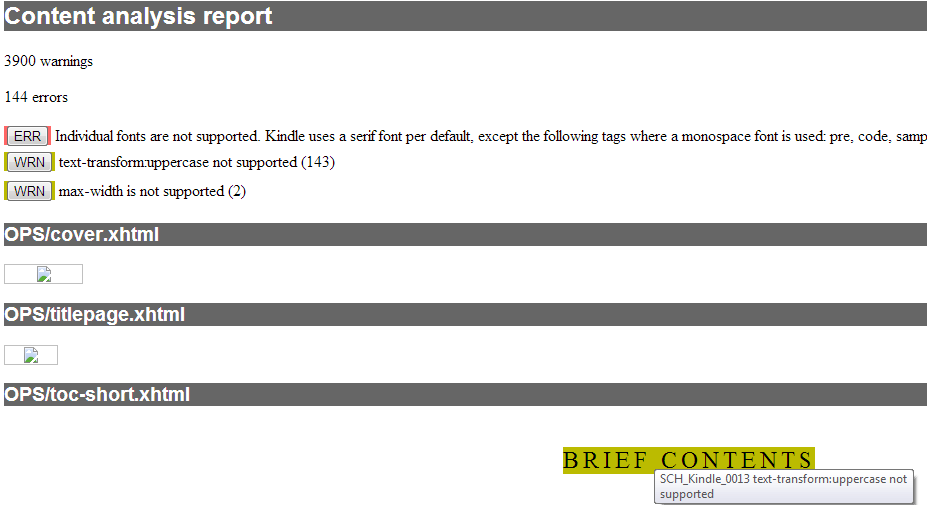
|
|
|
|
n×m |
n+m |
|---|
Technologies: XProc, XSLT2, Relax NG, Schematron
.foo {
font-size: 10pt;
line-height:1.3em;
hyphens: auto;
}
central style (here: class) ⇒ named rule
<css:rule name="foo" css:font-size="10pt" css:line-height="1.3em" css:hyphens="auto"/>
<p style="margin-bottom:6pt; color:red"> text </p>
local overrides ⇒ prefixed attributes
<p css:margin-bottom="6pt" css:color="red"> text </p>
InDesign’s native layout representation
IDML |
|
|---|---|
|
|
<ParagraphStyle Self="ParagraphStyle/test"
Name="test"
Imported="false"
NextStyle="ParagraphStyle/test"
KeyboardShortcut="0 0"
FillColor="Color/C=75 M=5 Y=100 K=0"
FontStyle="Bold"
PointSize="14"
SpaceBefore="5.669291338582678"
SpaceAfter="5.669291338582678">
<Properties>
<BasedOn type="string">$ID/[No paragraph style]</BasedOn>
<PreviewColor type="enumeration">Nothing</PreviewColor>
<AppliedFont type="string">Minion Pro</AppliedFont>
</Properties>
|
Word’s native layout representation
OOXML |
|
|---|---|
|
|
<w:style w:type="paragraph" w:customStyle="1" w:styleId="test">
<w:name w:val="test"/>
<w:pPr>
<w:spacing w:before="113" w:after="113"/>
</w:pPr>
<w:rPr>
<w:rFonts w:ascii="Minion Pro" w:hAnsi="Minion Pro"/>
<w:b/>
<w:color w:val="339966"/>
<w:sz w:val="28"/>
</w:rPr>
</w:style>
|
|
OOXML |
IDML |
|---|---|
<css:rule name="test"
layout-type="para"
css:color="#339966"
css:font-family="Minion Pro"
css:font-size="14pt"
css:font-weight="bold"
css:margin-bottom="5.65pt"
css:margin-top="5.65pt"/>
|
<css:rule name="test"
layout-type="para"
css:color="device-cmyk(0.75,0.05,1,0)"
css:font-family="Minion Pro"
css:font-size="14pt"
css:font-weight="bold"
css:margin-bottom="5.65pt"
css:margin-top="5.65pt"/>
|
Not part of the CSSa spec.
But we’ve developed a CSS expander for HTML:
<html xmlns="http://www.w3.org/1999/xhtml">
<head>
<style type="text/css">
.foo > p { color:red; }
p { color:blue; }
p { color:green; }
</style>
</head>
<body>
<div class="foo">
<p>foo</p>
</div>
<p>plain</p>
</body>
</html>
<style type="text/css" xml:space="preserve">
.foo > p { color:red; }
p { color:blue; }
p { color:green; }
</style>
</head>
<body>
<div class="foo">
<p css:color="red">foo</p>
</div>
<p css:color="green">plain</p>
</body>
$ calabash.sh -i source=test.xhtml \
-o result=out.xhtml css-expand/xpl/css.xpl
<s:pattern id="css-text">
<s:rule
context="*[@css:text-transform]">
<s:report
test="@css:text-transform eq 'uppercase'">
<s:span class="severity">WRN</s:span>
<s:span class="msgid">SCH_Kindle_0013</s:span>
text-transform:uppercase not supported
</s:report>
</s:rule>
……

When synthesizing IDML, you can use centralized styles, except for table widths.
Style HTML with central CSS; selectively CSS-expand it; trivially transform td/@css:width to the
corresponding IDML property. XProc step:
<css:expand path-constraint="[self::*:td]" prop-constraint="width"/>
There isn’t (yet). But there is a Relax NG schema
<define name="css_pattern.length">
<data type="token">
<param name="pattern">\+?(\.[0-9]+|[0-9]+\.?([0-9]+)?)(px|em|ex|in|cm|mm|pt|pc)</param>
</data>
</define>
<define name="css_pattern.padding">
<choice>
<ref name="css_pattern.length"/>
<ref name="css_pattern.percentage"/>
</choice>
</define><define name="css_att.padding-left">
<optional>
<attribute name="css:padding-left">
<ref name="css_pattern.padding"/>
</attribute>
</optional>
</define>
<define name="css_attributes">
<interleave>
……
<ref name="css_att.padding-left"/>
……
<ref name="css_pseudo_att.marker_font-weight"/>
<ref name="custom.css-like.attributes"/>
</interleave>
</define>The schema comprises:
flat DocBook + CSSa + Tabs + <br/>
<?xml version="1.0" encoding="utf-8"?> <?xml-model href="http://www.le-tex.de/resource/schema/hub/1.1/hub.rng" type="application/xml" schematypens="http://relaxng.org/ns/structure/1.0"?> <?xml-model href="http://www.le-tex.de/resource/schema/hub/1.1/hub.rng" type="application/xml" schematypens="http://purl.oclc.org/dsdl/schematron"?> <hub xmlns="http://docbook.org/ns/docbook" xmlns:css="http://www.w3.org/1996/css" version="5.1-variant le-tex_Hub-1.1" css:version="3.0-variant le-tex_Hub-1.1" css:rule-selection-attribute="role">
docx2hub and idml2hub converters available
<info>
<keywordset role="hub">
<keyword role="source-basename">muster1</keyword>
<keyword role="source-dir-uri">file://…/muster1.idml.tmp/</keyword>
<keyword role="source-paths">false</keyword>
<keyword role="formatting-deviations-only">true</keyword>
<keyword role="source-type">idml</keyword>
</keywordset>
<css:rules>
<css:rule name="p_Musterseite_p_column_left"
native-name="p:Musterseite:p_column_left"
layout-type="para"
css:font-size="9pt"
xml:lang="de"
css:text-align="center"
css:text-align-last="center">
<tabs>
<tab align="center"
alignment-char="."
leader=""
horizontal-position="170pt"/>
</tabs>
</css:rule>
Selectors ← XPath is better
ul.nav > ul > li:first-child
Properties ← interesting
font-weight: 600; color: rgba(0,0,0,0.4);
Precedence rules ← complex
#main div { color: red }
div.foo { color: blue }
IDML example
<ParagraphStyle Self="ParagraphStyle/AB_Text_List_Item"
Name="AB_Text_List_Item"
LeftIndent="14.173228346456694"
FirstLineIndent="-14.173228346456694">
<Properties>
<BasedOn type="object">ParagraphStyle/AB_Text</BasedOn>
<BulletChar BulletCharacterType="UnicodeWithFont" BulletCharacterValue="8226"/>
<BulletsFont type="string">Arial Unicode MS</BulletsFont>
</Properties>
</ParagraphStyle>
Translates to (including props inherited from AB_Text):
<css:rule name="AB_Text_List_Item" layout-type="para" css:font-size="9.5pt" xml:lang="de" css:font-family="Arial Unicode MS" css:pseudo-marker_content="'•'" css:pseudo-marker_font-family="Arial Unicode MS" css:margin-left="14.15pt" css:text-indent="-14.15pt"/>
No based-on inheritance in named rules (simplification).
Allowed: style composition
<para role="foo bar">
If named rules foo and bar define the same property, the last-defined in document order wins, as in CSS.
Schematron author has to make sure
that the last defined wins
<rule context="dbk:para">
<let name="roles"
value="tokenize(@role, '\s+')"/>
<let name="rules"
value="/*/dbk:info/css:rules/css:rule[@name = $roles]"/>
<report
test="matches(
('', ($rules | .)/@css:font-weight)[last()],
'^(bold|[6-9]00)$'
)">Is this all-boldface paragraph
a heading?</report>
The Web is moving in the opposite direction:
CSS-like selectors in jQuery, …
<div id="content"> …… <video src="movie.mp4" preload="auto"> ……
⇒
video {
preload: metadata;
}
#content video {
preload: auto;
}